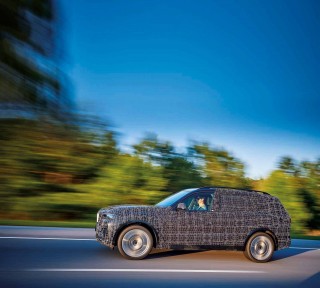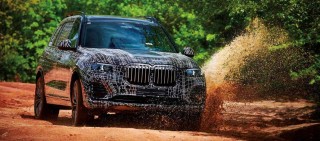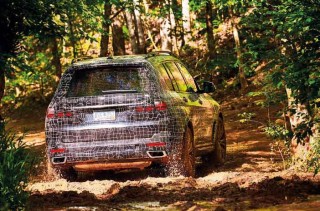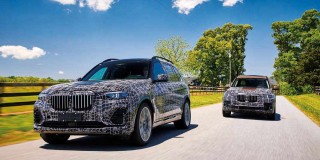It only seems like a few years ago that BMW was launching the original X5 but, incredibly, that model will be celebrating its 20th birthday in 2019.
Now we’re at a point where the Munich concern has seven sports utility vehicles; seven! It would have been inconceivable to imagine such a position in, say, 1996, when the smallest Beemer you could buy was a 3 Series. How times – and the market – have changed!
SIGNIFICANT NUMBER
Seven is an important number, though, because what we’re dealing with here is the pre-production X7, the marque’s new, high-riding flagship. The seven relates to both its characteristic link to the longtime grandest saloon in BMW’s legendary history, the 7 Series, and also to the number of seats this SUV has on board. The standard configuration for the X7 will be arranged in a 2-3-2 layout, but an option will see the middle bench junked for a couple of ‘captain’s chairs’ that aren’t, in fact, dragged from an ocean-going vessel, but are the front seats (with minor modifications) from the impending 8 Series Coupé. The six-seat X7 is the more luxurious option, by the way.

Thus, the X7 sits on the largest evolution of the ‘cluster architecture’ (CLAR) platform that pretty much underpins everything in the manufacturer’s portfolio, bar the ‘front architecture’ cars such as the X1, X2 and 2 Series Active/Gran Tourer models (and everything in the MINI sub-marque, as well). Using CLAR almost certainly paves the way for a plug-in hybrid X7 in the very near future, although we’re getting ahead of ourselves here with idle speculation. For now, there are many aspects of the BMW X7 family still shrouded in secrecy ahead of the SUV’s launch at the beginning of 2019. We don’t know, for instance, the exact outputs of the launch engines, nor any of the performance or ‘green’ data for the model line. However, the broad strokes are these. Four models will form the X7 vanguard, split into two petrols and two diesels. One of these will wear an ‘M’ badge, albeit the tricolour-striped letter of M Performance, and – yes, you guessed it – the performance version will actually be one of the diesels.
ENGINE OPTIONS
Kicking things off on the petrol side will be the tried and trusted 3.0-litre twin-turbo straight-six, likely to wear ‘xDrive40i’ badging. Above that, there will be a 4.4-litre bi-turbo V8, using the engine that’s already in regular service elsewhere in the BMW family, and which will probably carry ‘xDrive50i’ nameplates. As a guide, expect around 340hp and 369lb ft from the 40i, and 462hp with 480lb ft from the 50i. Moving on to the diesels, there’s just one capacity engine – a 3.0-litre straight-six – but what differentiates the models here will be the number of turbos bolted to the main lump. With just one blower fitted, the expected xDrive30d model should boast around 265hp and a healthy 458lb ft, while it’s not beyond the realms of imagination to believe the twin-turbo variant (often badged 40d) will make an appearance at some point, with its 320hp and 502lb ft outputs.

But what if a bi-turbo diesel’s not enough for you? Then you’ll want the M50d, with its four turbochargers. This is the engine seen in the European-model 750d, which we don’t get here, and it churns out colossal figures of 400hp and 561lb ft. This is why it earns the M Performance epithet, over and above the 4.4 V8 petrol. We’re hoping the M50d is confirmed for the UK but, at the moment, BMW isn’t prepared to say exactly which variants are coming to these shores.
EIGHT-SPEED STANDARD
No matter which powerplant you go for in the X7, it will be mated to an eight-speed, Steptronic automatic gearbox as standard, with the whole lot coupled to xDrive all-wheel drive. This system has been developed for the X7 as a new application, which can apportion torque faster on a front-to-rear basis. This promotes cornering agility by negating under- and oversteer wherever possible. All X7s will also get twin-axle air suspension as standard, like the 7 Series, with chassis/drivetrain options confirmed so far to include active antiroll bars, Integral Active Steering (IAS, or four-wheel steer, in plainer English) and a Sports exhaust system. There will also be an Off-Road Package, which adds a limited-slip differential to the rear axle and underbody guards.

Inside, we’ve already touched on the layout of the seats, but it’s worth highlighting the space they afford. The X7 arrives despite the fact that the outgoing F15 X5 has a seven-seat option, and its impending fourth-generation successor will most likely continue to offer such a facility. But, whereas the X5 has five, full-sized seats with a couple of occasional chairs in the third row (read: for children only), two six-foot adults could happily sit in the back of the X7 for extended periods of time. OK, it’s not exactly cavernous back there, but there’s enough leg- and headroom to make it a pleasant place to sit. The boot, however, isn’t anything to shout about when there’s a full complement of humans onboard.
Up front, the X7 will be the third BMW to sport the latest iDrive 7 operating system on a huge 12.3in display, and it’ll also gain a fresh design of digital instrument cluster with angular ‘dials’, rather than round ones. Due to BMW’s corporate communications policy, we can’t say yet which two models will be the pioneers of iDrive 7 and TFT cluster (also 12.3 inches) but, if you know BMW’s intended product release strategy for the rest of 2018, you can probably have a good guess at which pair of machines they’ll be.
DETAIL TOUCHES
There were also more details to note, such as new digital climate controls, knurled metal switchgear and rotary dials, plus an optional Swarovski crystal gear lever, which all aim to improve the interior ambience even further than that already found on the Seven. BMW hid much of the dashboard on the test X7s, but it’s obvious from the brand’s recent interior efforts, that the fit and finish should be exemplary in this high-sided luxury beast.

So, to the driving. BMW says it is ‘80% there’ on final calibrations for the X7, with the pre-production prototypes still having one or two minor issues to be resolved. We got a chance to have a go in the entire launch range; two examples of the 40i, one with IAS and a Sport exhaust, the other with active anti-roll bars; two examples of the 50i, one in fully-laden luxury spec and the other fitted with an Off-Road Package (ORP); a 30d, without the ORP (strangely), for a reasonably tame off-road course; and the monster M50d for the journey back to base. Some of these cars had a six-seat layout, others seven, a few rode on 21in wheels and yet others were on whopping 22s.
No matter which variant we tested, the on-road refinement was off-the-scale impressive. With only some minor ruffling of wind noise around the B-pillars at speed to report, which BMW assured us was due to the exterior camouflage, the rest of the sound suppression in the cabin was magnificent.
Acoustic glass is used for the windscreen and side windows, while masses of hidden sound-deadening partly accounts for the X7’s 2,300kg kerb weight (it doesn’t use Carbon Core construction like the 7 Series), but the results are exceptional. Keep any of the engines available in the SUV below 3,000rpm and the big X7 just whispers along in near-silence, the air suspension smoothing out all the worst lumps and bumps in the road surface.
IMPRESSIVE PERFORMER
The X7 also ‘shrinks to fit’. It didn’t take long behind the wheel to work out the this BMW is no lumbering tank to drive. Nicely judged controls and excellent visibility out in all directions, ensured it was easy to place accurately on the road, while all the engines did a grand job of moving the SUV’s bulk around easily. It was certainly as at-ease in tighter urban conditions as it was out on the motorway cruising along at a steady 70mph, which is a neat trick to pull off. However, the handling impressed most of all. If not quite as nimble as an X3 or X5 in the curves, the X7 nevertheless belied its stature when we started throwing it around on a twisty road. True, there was more sensation of lean during cornering and weight transfer when braking hard or accelerating sharply, in the models without the active anti-roll equipment, but at no point did the X7 tilt over in an alarming fashion. Instead, it settled its weight neatly on the outer two wheels, then stayed rocksteady as we traced-out the line of the curve. Admittedly, the anti-roll stabilisation makes the X7 even more impressive for handling, and there’s genuine pleasure to be had from stringing it through a series of bends at speed.

BMW’s main focus has been to make sure the X7 is exceptionally refined at all times, and the manufacturer has emphatically done that, providing the SUV with tranquil cruising manners that are easily the match of a full-sized Range Rover, and a long way ahead of its only comparable Teutonic rival, the Mercedes GLS. But BMW has also managed to preserve that dynamic edge that marks out all of its products, the X7 having a chassis that can entertain its driver under the right circumstances. The steering is worthy of praise too, which is doubly admirable given there are two calibrations, depending on whether the rear wheels of the SUV turn or not.
Sometimes, it isn’t hugely informative to drive a prototype a long way ahead of production, as much can change in the final 20% of development before a model gets to market. But, in the case of the BMW X7, it’s already clear that the company is on to a real winner here. Blending all the refinement and opulence of the 7 Series with some of the dynamic acuity of vehicles like the X3 and X5, the largest SUV from Bavaria is almost certainly going to enter a whole new automotive class as the market leader.
It’s practical, it’s plush and it’s pacey and, provided the looks aren’t hideous once the wraps finally come off (and the price isn’t too strong), then BMW has cooked-up another cracking creation.
All this bodes well for the inevitable companion model, the X8, doesn’t it? It surely has to be in the pipeline – after all, every other odd-number X-vehicle has an even-numbered analogue… and the 8 Series can’t be left without an SUV version, now can it? Eight SUVs; who’d have thought that would be possible 20 years ago?

The X7 sits on the largest evolution of the ‘cluster architecture’ (CLAR) platform
At the moment, BMW isn’t prepared to say exactly which variants are coming to these shores.
No matter which variant we tested, the on-road refinement was off-the-scale impressive.
It’s hard to imagine many future X7 owners treating their expensive possession like this.
BMW wouldn’t allow the X7’s sumptuous interior to be photographed…
Apart from some minor, exterior camouflage-induced wind noise at speed, the sound suppression in the cabin was magnificent.
Although the off-road test course was relatively tame, the BMW X7 does seem capable when the going gets rough.
There will also be an Off-Road Package available for the X7, adding a limited-slip differential to the rear axle and underbody guards.
CAR: 2019 BMW X7 xDrive50i (pre-production prototype) G07
PRICE: TBC
DRIVETRAIN: 4.4-litre twin-turbocharged V8 petrol, eight-speed Steptronic auto, xDrive four-wheel drive
ECONOMY: TBC
CO2 EMISSIONS: TBC
TOP SPEED: TBC
0-62MPH: TBC
POWER: approx. 462hp
TORQUE: approx. 480lb ft





